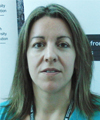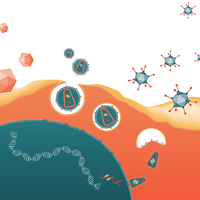Continuous flow centrifugation: importance in vector scale up
Cell Gene Therapy Insights 2016; 2(5), 577-582.
10.18609/cgti.2016.069


Sandra Meriño has been the Global Project Director at Alfa Wassermann Separation Technologies group for 16 years managing process support, product installation and validation including PQ testing. Previously worked at Medeva (now Seqirus) in the UK as a downstream processing scientist working on traditional and recombinant viral and bacterial vaccine scale up and scale down. Holding a BSc Hons in Biological sciences and Biochemistry form Manchester University.
Scott Glanzman is the Director of Marketing for Alfa Wassermann Separation Technologies and holds a Bachelor of Science in Education from Indiana University. Beginning over 36 years ago in secondary education, he applied that experience to a career that lead to senior positions in sales and marketing at companies that included McKesson Medical-Surgical, ThermoFisher, and Roche Diagnostics.
Can you provide some background information on what continuous flow centrifugation is?
SM: continuous flow centrifugation technique is widely known for its use in the clarification of bulk materials, for example disc stack centrifuges. But as a tool for the purification of viruses, viral vectors, or particulate materials, it’s not so widely known. This centrifuge, or ultra-centrifuge, can substitute for a chromatography or filtration step in a purification protocol.
In the laboratory tube rotors are often used and offer an excellent purification option for small quantities of material, but are limited when it comes to scale up. The solution to this is to employ a continuous flow ultracentrifuge, where sample size is not limited by rotor volume, as the feed stream
will continually enter the rotor during high-speed operation.
In this way, a sample load for example of 50 fold can be loaded, concentrated and purified to over 95% purity in one step. The way this works is that the ultracentrifuges use rotors known as zonal rotors, which are one hollow tube per centrifuge divided into segments. Within these segments a density gradient can be formed, within which viral vectors and virus of interest can be purified.
As more gene therapies move into clinical trials, there’s an increased need for scalable, efficient vector production. What do you perceive to be the biggest opportunities within vector manufacturing that can help us achieve this?
SM: In order to move to more commercial-scale manufacturing, your equipment and process methodology need to be suitable for scale up. Where our centrifuges can support this is that they are truly scalable. There is a perception in the market that ultracentrifugation is not scalable; when looking at tube rotors in the laboratory setting, then clearly to scale those up you would need either a different centrifuge or 10 to 20 of the same centrifuge and that simply is not efficient or cost effective.
What we can provide are truly scalable centrifuges. In this current market adeno-associated virus (AAV) is a very important vector which has entered into many clinical trials, with over 42 trials currently open. These trials are phase 1 and phase 2, and eventually they will need to reach a manufacturing scale. Downstream processing can be a bottleneck if you thought you were going to employ 10 small centrifuges. Because of this perception, a lot of people choose chromatography instead or centrifugation. This prompted us to carry out some studies to demonstrate our continuous flow centrifugation can be that downstream processing step of choice.
SM: As Sandra mentioned, we certainly have identified a market need for scalability and of course cost is always a key consideration when looking at process scale up. When you have the opportunity to go from research production to full scale production, and not have to start over again at each stop along the way, that’s a very important benefit and can be incredibly cost effective. That’s where our systems, our process, come into play.
Alfa Wasserman have been in this business for over 45 years and we’ve been involved in process development and industrial-scale manufacturing, predominantly in vaccine production. We are totally home-grown, we never third party any service or support. There are a range of ultracentrifuges each with the linear process scalability which is a significant benefit, as well as our systems being incredibly robust.
SM: I think it’s also important to clarify what we mean when we talk about scale up. We have a rotor of a fixed size, but as it scales up as a continuous flow centrifuge – while it’s spinning at the operating speed – fluid is continually pumped through that rotor. So that means for any of our rotors, you can you load more than 40 times your actual rotor volume of your process fluid, which allows concentration at the same time as purification.
You mentioned you’d recently undertaken a study to look at the potential use of centrifugation as a purification technique for viral vectors. Can you describe the rationale and methodology?
SM: We’re always looking at viruses, viral vectors, nanoparticles, exosomes, all sorts of particles that can be purified in a centrifuge. As this is an ultracentrifuge, it’s not a low speed machine, it’s high-speed used for purifying very small particles from background material. It can accommodate anything up from 50 nanometers right up to 1000 nanometers. AAV falls into this range of particles that can be purified. As we’ve already identified there is a need in the market for scale up, particularly since AAV is one of the most commonly used vectors at the moment in clinical trials, we decided to undertake a study to demonstrate our centrifuge’s capability in purifying this vector.
We collaborated with Virovek, a Hayward, California-based company who produced the material for this study and with our centrifuge installed in their facility we carried out a number of test runs to try and establish the best protocol.
Currently there are no efficient large-scale separation methods. Small-scale methods use caesium chloride density gradients in tubes, or iodixanol density gradients in small tubes. We decided to use a wave bioreactor to grow S9 cells and use a baculovirus system that is proprietary to Virovek, to generate the AAV particles.
This material was then analyzed, clarified with low-speed centrifugation to remove large particles, and processed through the Alfa Wassermann centrifuge.
What were the main outcomes and how did these prepare with your expectations?
SM: On a small scale, caesium chloride density gradient is very commonly used. In fact that’s the process Virovek were using in their normal processes. So we first tried to establish caesium chloride as a continuous flow density gradient inside the rotor but found this was not possible. The main reason is there’s a degree of stability required in continuous flow density gradient centrifugation. This is established through the viscosity of the medium and caesium chloride has very low viscosity.
That led us to then try iodixanol, which was found to have sufficient viscosity to form a stable gradient. We then performed some test runs with a background buffer, PBS, some sodium citrate, which is well established as a standard medium for using in the background of AAV purifications, and we achieved get a good capture rate.
Therefore, we loaded lysate, if you’ve taken your cell culture, collected your cells, lyzed those cells to release the AAV, then you have quite high protein material. That can then be loaded directly into the centrifuge without any further concentration step. In our first profiles we got a very clear peak of AAV in the gradient, which was round about the 2.8 x 1013 particles in that peak, which is quite substantial.
We also established a very nice density gradient in the rotor. The peak of the product was round about the 42/43% iodixionol, which is where you would expect it to be. When we analyzed that with SDS PAGE, we obtained a very pure sample. There were a few extraneous proteins lurking in the lower molecular weight levels of the SDS PAGE. So at first we thought that maybe we were overloading the gradient, with too much lysate going in, and too much total protein. Therefore we performed a second run of that material peak and then diluted it back down to reduce density. What we actually saw was that although we recovered a substantial amount of AAV, we did have a single protein that seemed to be tracking with the particle. Our conclusion was that this was associated with the surface of the particle and wasn’t just in the background material.
This led us to see if we could disassociate that single protein. When tube gradients are made with caesium chloride, this strange protein is not seen, but using iodixanol then this protein is often seen associated with the particle. We decided to add a small amount of caesium chloride back into that iodixonal mix in the buffer, as a background modifier. That changed the ionic strength of the solution, which led to a further result, and in that second SDS PAGE we could see in fact we had purity equal to that of a caesium chloride gradient. In that purification, when we loaded that lysate to the centrifuge, even with that extra band associated with the particles, we were achieving about a 55% yield, which is fairly good for a single step protocol. Utilizing this process you can go from lysate to pure product in one step. Now that’s a very significant process advantage as typically 3 or 4 rounds of chromatography might be required to achieve a similar yield and reported yields have been down at about 20%.
In a single step, with 55% yield, we feel we have a pretty robust method for collecting AAV particles. This research was all undertaken on our research size machine, the AW PromatixTM 1000. This is a small unit we can put into research facilities, it has a very small footprint, and is a mobile machine. We also have large-scale machines used in the vaccine manufacturing industry. This is called KII and has 27-fold larger rotor than what we used for this Promatix study.
Therefore, it’s possible to extrapolate that peak of 2.8 x 1013 particles we collected that was about 20 ml, could scale up then to 540 ml, from a KII rotor. That’s a substantial amount of pure AAV vector and supports the use of ultra-centrifugation as part of a commercially viable scale up process. Furthermore, this purification of AAV as a physical separation means you can have different constructs in AAV, different therapies and they will all purify in a similar fashion thus removing the need to keep redefining the test protocol.
This study was focused on the purification of AAV vectors, whether they are full or empty capsids was not investigated as the size differential between the two is very small; however, we are keen to look into this in the near future.
What relevance can we draw from this in terms of large scale manufacturing of vectors? The commonly held perception is that centrifugation is not a scalable process. Is that correct?
SM: Centrifugation on a laboratory scale, using tube rotors, is not a scalable method. But here we’re talking about a specific piece of equipment for which we have linear scale up. What I mean by that is the experiment we performed on a 120 ml rotor will directly translate to a 3.2-liter rotor. The only difference is the volume of product you load and the flow rate you use would be multiplied.
This means you can process a 10 liter batch on a Promatix at small scale and move to a 200 liter batch on a large scale. With scalable rotors we retain their linear scale by having the same maximum: minimum radius.
It’s also the case that within a centrifuge, for example the PK, our pilot scale centrifuge, we have different rotor cores that will establish different volumes within one rotor. For example a 400 ml rotor, an 800 ml rotor and a 1600 ml rotor can all be created using the same rotor assembly, by simply changing the inserts inside that rotor. This means inside one machine you can process 10 and 50 liter batches.
One factor that is critical for scale up to clinical trial stage is that your production process is compliant with the cGMP requirements. This is central to the Alfa Wasserman manufacturing and testing of centrifuges. We come from a background of large-scale GMP-compliant centrifuges. The laboratory centrifuge, the Promatix, is a unique product that enables people to do test work at volumes of less than 10 liters but retain the same critical separation parameters of the cGMP KII ultracentrifuge. Laboratory centrifuges, although they may be valid at small scale, often lack this cGMP compliance in terms of the validation and test package and can therefore present a compromise when scaling up.
While the study looks at AAV, do you feel this is applicable to additional vectors, including perhaps next generation non-viral vectors?
SM: Absolutely. The centrifuge can be used as a purification tool for any particle between 50 and 1000 nanometers. That could be exosomes, nano-particles, nano-structures etc. There’s a lot of work at the moment looking at exosomes as part of cells that also need purified. These seem to provide a good gene therapy, because they are recognized as cells, so they can go into tissues where other systems might be rejected.
This centrifuge came initially from influenza vaccine manufacture, but has been used for all sorts of things, including hepatitis B, rabies, adeno and vaccinia vectors. So centrifugation is a physical separation method that is not affected by the chemistry of the particles, therefore it’s going to separate lots of different constructs a company might be making, all in the same way, in a very generic process. This means you can use this process across your pipeline for more than one vector or vector construct that is being purified.
Have you run this process with lentivirus and other viral vectors?
SM: We’ve certainly looked at purification of lentivirus and it tends to be a little bit more delicate. Similar work has been done with respiratory syncytial virus (RSV) which some people say you can’t centrifuge because it will fall apart. However, other groups have centrifuged RSV and had great successes. Some of this seems to be related to the shear factor caused when liquid coming into the stationary machine suddenly starts to swirl. What we see on our centrifuges is we have quite a long transition zone from the stationary to the turning phase and this seems to reduce the shear factor which can be a problem on laboratory scale continuous flow machines.
SG: Whilst AAV was selected for this particular study, given the 42 ongoing clinical trials using this vector, we feel confident that our continuous flow ultra-centrifugation will achieve similar unsurpassed levels of purity, and yield, for additional viral vectors and with the added benefit of facilitating the move from research scale to production.
You can access the poster here for a full overview of the study and outcomes discussed here.
This work is licensed under a Creative Commons Attribution- NonCommercial – NoDerivatives 4.0 International License.

